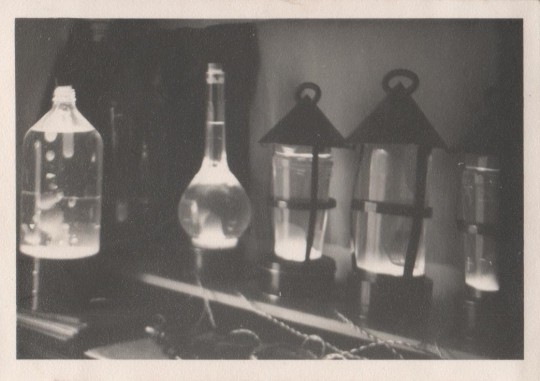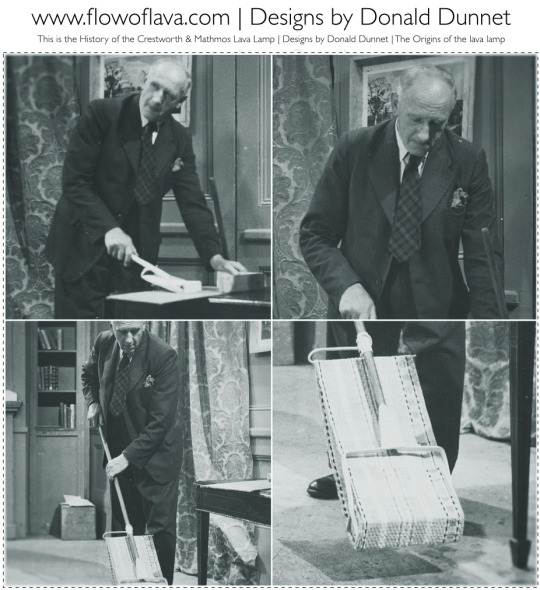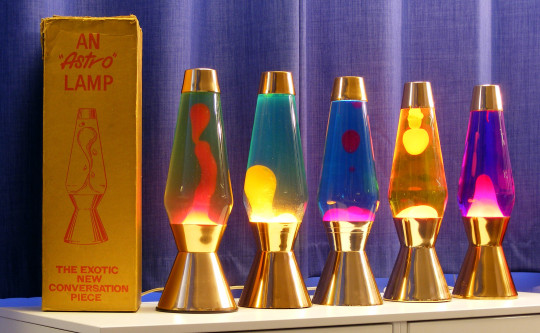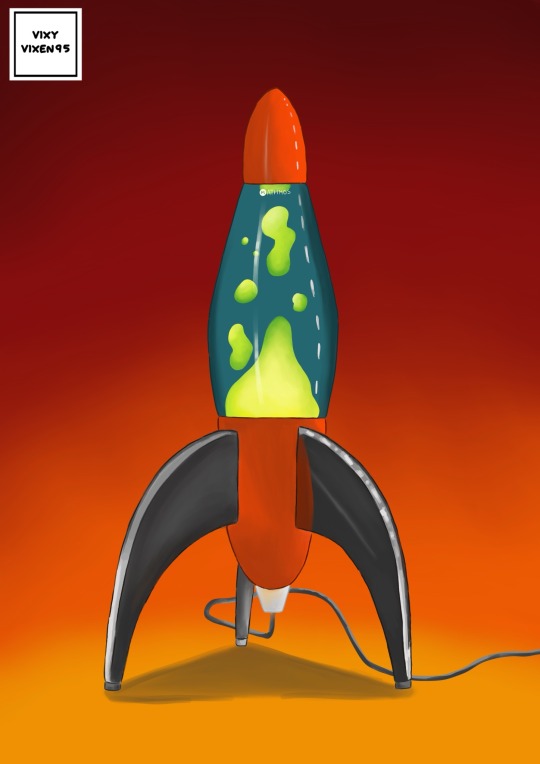#mathmos lava lamps
Explore tagged Tumblr posts
Text

MATHMOS LAVA LAMPS
#mathmos#mathmos lava lamps#product design#interior design#decor#lava lamps#modern interior design#home decor ideas#decor inspo#vintange interior design#futuristic#furniture#lamps#designer
26 notes
·
View notes
Text
THE FIRST LAVA LAMP...?
The history of the lava lamp can be quite muddled and confusing to approach. From its original invention to its manufacturing and sale, who exactly “did it first” is often unclear. Two lava lamp companies, Lava Lite and Mathmos, are said to be the originators of the lava lamp, and both draw their histories back to inventor Edward Craven Walker… Who himself is disputed as the true inventor of the lava lamp.
So, what’s the real story?
Well, it starts sometime in the 1940s with a Scot by the name of Donald Dunnet, a motor engineer living in South East England. Little information is available on Dunnet, and the most helpful source on him and his inventions is his great-grandson Charlie Leverett, who along with his father and aunt have tried to piece together accurate information on Dunnet and his invention.
According to an old (unfortunately dateless) newspaper article, which the family uses as a source, the original invention came about when Felicity, Dunnet’s youngest daughter and Charlie Leverett’s grandmother, broke the family’s egg-timer, coincidentally while there was a wartime shortage of egg-timers in the UK. Dunnet, who was described as a part-time inventor, set out to build a replacement – imagining, instead of sand falling down to measure time, a controlled rising of oil to the surface of water. This “inverted egg-timer” would therefore be the very first lava lamp prototype.
It would not, however, be the last prototype created by Donald Dunnet. In December 1950, Dunnet applied for a patent granted in 1954 for “a display device using liquid bubbles in another liquid” – making no reference to time measurement, it can be assumed that at this point the invention no longer had anything to do with egg-timers and was instead meant to be an aesthetically pleasing display.
The abstract further describes the invention as “a display device [which] comprises an upper layer of liquid 2 and a lower layer of liquid 3 in a transparent container 1, the two liquids being non-miscible and the upper layer being of lower specific gravity than the lower layer and means 9 for heating the lower layer so that it rises through the upper layer in the form of liquid bubbles […], the bubbles being cooled by the upper layer so that they return to the lower layer.”
Further technical detail is added, but with this initial description, you may already have recognized the basic workings of a lava lamp: wax or oil heated by a light bulb at the bottom of the lamp bubbles up through the fluid filling the container (typically water); the bubbles cool down as they reach the top of the lamp and fall back to the bottom, creating a continuous flow of 'lava'.
While there are no other patents I could find for further iterations on this invention, Dunnet continued to improve on his design. The family was able to find one picture of various models created by Dunnet: one resembles a large glass jug, one a long-necked, bulbous bottle, and three resemble lanterns (interestingly, lantern designs would later be sold by both Lava Lite and Crestworth). The picture is dated "Easter 1960".

Dunnet was even featured on “The BBC Inventors Club” (date of broadcast unknown) for another of his inventions, seemingly his “cleaner for flat surfaces” patented in 1955, pictured here:

According to Dunnet’s grandson, in the 1960s, the family still owned and used one of Dunnet’s lamps, which he says “worked really well and was well developed, quite far removed from his original ‘egg timer’ based design”. He further describes this lamp as using “a Grant’s whiskey bottle with Red lava”. He also declared his intention to create a replica of this prototype based on his memories of it, but it seems pictures of such a replica never materialized.
Sadly, Donald Dunnet passed away sometime between 1960 and 1964, and would never market his invention himself. According to his grandson, his widow had his workshop completely cleared after his death, and no surviving prototypes remain. Still – thanks to newspaper articles, family testimony, the 1950s patent, and the surviving photographs of Donald Dunnet and his inventions, it seems clear that he was the true original inventor of the lava lamp, though not the one who would come to market it to the public.
Unfortunately, Dunnet seems to have been widely forgotten from lava lamp history, with many sources not mentioning him at all, and only his initial egg-timer prototype being briefly credited as inspiring Edward Craven Walker in other sources. It seems Dunnet’s family passed on his story through generations and often spoke of his invention as being stolen, though his granddaughter Linda Leverett is “not sure what really happened”, and the family primarily expresses wishing that he was better known and recognized for his creations. You can take a look at various other patents held by Dunnet here.
So then, who is this Edward Craven Walker we keep hearing about?
Edward Craven Walker (1918-2000) was a British inventor, now known as the creator of the lava lamp. In 1963, Craven Walker found himself at the Queen’s Head pub in Dorset, England. There, he spotted a “blob light” on the bar, described as “a glass cocktail shaker full of oil and water with a light bulb beneath”. This was one iteration of Dunnet’s invention – already no longer an egg-timer as is often claimed, but instead a decorative item.
Craven Walker, learning that Dunnet had died, decided to take on the further development of the lamp himself. He hired British inventor David George Smith to further develop the device. In 1964, Smith applied for a patent assigned to Craven Walker’s company ‘Crestworth Limited’ and granted in 1968, for “a display device comprising a container having two substances therein, with one of the substances being of a heavier specific gravity and immiscible with the other substance […] and when heat is applied to the container, the first substance will become flowable and move about in the other substance”.

Craven Walker named this lamp the “Astro Lamp”, and this model was sold by Crestworth starting in 1963, making it the first commercial lava lamp.

The Crestworth Astro and its variations (such as the Astro Mini) have defined the classic look of lava lamps ever since. They were greatly successful throughout the 1960s and 1970s and are now icons of the era. Crestworth would be renamed Mathmos in 1992, and Mathmos is still one of the two best-known lava lamp companies in the world.
So, what’s with Lava Lite and its claim of being “the original lava lamp company”?
In the end, it’s simply a case of international manufacturing rights. In 1965, Craven Walker sold the US manufacturing rights of his Astro Lamp to two American entrepreneurs, Adolph Wertheimer and Hy Spector, who saw the lamp at a novelty convention in Hamburg, West Germany. Wertheimer and Spector founded the Lava Manufacturing Corporation in Chicago, Illinois, and the Astro Lamp was renamed the Lava Lite and brought to the US market. In the 1970s, the rights to the Lava Lite were sold to Haggerty Enterprises, and it would be distributed by a subsidiary called Lava World International. Lava World International was later renamed Lava Lite LLC. Finally, the Lava Lamp brand was acquired by toy manufacturer Schylling in 2018. This brand, often referred to as “Lava Lite”, is the other big player in the lava lamp world. Because both Mathmos and Lava Lite originate from Craven Walker’s initial Astro Lamp, both brands still lay claim to “the original lava lamp”.
So that’s the story of the lava lamp, as best as I’ve been able to piece it together! An original invention by Donald Dunnet, developed by Edward Craven Walker, and sold in the US by Lava Lite and internationally by Mathmos. A simple but ingenious device, originally only meant as an egg-timer, which would become an icon of the 60s and the 70s, and remains popular to this day.
Did I get something wrong? Am I missing details? Do you have more information on lava lamp history? Feel free to reach out with an ask or submission!
Sources:
The History of the Astro Lamp - Designs by Donald Dunnet - FlowOfLava
The History of the Lava Lamp - Smithsonian Magazine
Donald Dunnet - Original Lava Lamps Inventor by Charlie Leverett on OozingGoo
The Mystique of the Lava Lamps - BBC
Craven Walker - The Telegraph
15 notes
·
View notes
Text
you would not believe how commonly i end up discussing lava lamp models in casual conversations. sometimes i feel like some sort of sitcom character with a pretty lame gimmick.
#97#someone at a party: oh they have a lava lamp thats cool#me: yup its a mathmos astro grande! the astro was actually the first commercialized lava lamp and its shape has remained pretty consistent#etc etc.
6 notes
·
View notes
Text

I know Mathmos are a bit longer like a real rocket, but yeah, mine a bit chunky and small 😅
Long live chunky mathmos!!

#lava lamp#mathmos#art#digital art#digital aritst#small artist#procreate#digital painting#painting#illustration#art study#vixyvixen95
1 note
·
View note
Text

21 notes
·
View notes
Note
“That’s fair. Alice once made one for Klee for her birthday, specially designed to be indestructible and safe. Which us a bit surprised for Alice, at least the ‘safe’ part.”
Diluc knocks on your door and enters slowly. “How are you doing, love?”
Tired. And frustrated with everything
#ooooooo#niceee#the original creators have one thats designed to be eftra safe and good for all ages#and it looks sooooo cool#(mathmos neo lava lamp)#i neeeeed a jellydish one tho of my goodness
9 notes
·
View notes
Note
What's the biggest most fuck-off huge lava lamp you have ever seen? That I can buy?
The biggest one that I've seen that you can buy is the saturn giant lava lamp made by mathmos. The height of it is 5 ft (1.5 m)
Here are some photos so you can really see how big this thing is.



46 notes
·
View notes
Text

Duran Duran have designed a fabulous variation of the classic Astro lava lamp by Mathmos, inventors of the lava lamp, to celebrate Mathmos' 60th Birthday. Every part of the lamp is customised, including signatures of each of the four band members etched into the cap and one of Duran Duran's early logos into the base.
Available to the UK and Europe only in a limited edition of only 600; exclusively available to buy now from all Mathmos websites - don’t wait to order, these will go fast. ✨ Limited to one per order.
54 notes
·
View notes
Text
Have y'all seen the European lava lamps? Apparently Mathmos doesn't sell in the United States or Canada and the lava lamp company has north american rights doesn't sell wall mounted or the lamps the come in other shapes they just sell the cheap versions.


36 notes
·
View notes
Text

Lava Lamp for Mathmos by Sabine Marcelis
7 notes
·
View notes
Text




Apparently they make non-electric lava lamps now????
3 notes
·
View notes
Text
The company that makes lava lamps is called Mathmos? MATHMOS?
As in like... the Matmos... the evil sentient bubbling goop (coincidentally looking and moving exactly like a lava lamp) is Barbarella?!!!
So... which came first... the movie, or the company name?!!

no idea where i was going with this but i abandoned it at the most disconcerting moment possible
103K notes
·
View notes
Text



x - x - x
MODEL: MK1 ASTRO LAMP
Brand: Crestworth
Introduced: 1964
Discontinued: 1965
Base and cap colors: brass
Wax colors: red, yellow, orange, green
Fluid colors: pink, yellow, clear, green, blue
Size: height 16 1/2“, base 5 1/4”
The Astro Lamp MK1 model was one of the very first lava lamps commercialized, sold by Crestworth (later renamed Mathmos) – only preceeded by the very first Astro Lamp, unofficially referred to as the MK0, which is rare enough to render information and pictures quite hard to dig up. I wanted to start off these reviews with as early a lamp as I could, so the MK1 seemed the best pick.
The Astro model has known many iterations since its 1963 introduction, and a modern Astro model is still sold today by Mathmos. However, for the purposes of cataloguing and reviewing, I will consider each generation of the Astro as a separate model, while acknowledging that the differences between generations may be so specific as to appear nonexistent (and I’m not good enough at recognizing them myself to be sure which generation I’m looking at!).
The Astro MK1 is the platonic ideal of the lava lamp; it’s probably more or less what you picture when you think of the words “lava lamp”, and I expect it always will be.
It features the traditional hourglass-shaped base, though in these early models the base is actually made up of two parts: two copper-colored cones which slide into one another, with the top cone containing the light bulb, and the power cable under it running through the bottom cone (see patent diagram below). In later lava lamps, the base would become a single piece.

The Astro is topped by a matching copper cap, which is notably shorter than what is seen in later lava lamp models. As with other lava lamps, the cap serves to hide the unsightly closure at the top of the glass globe.
Though the original Astro Lamp only offered a copper base/cap, it did come in a variety of wax and fluid colors.

A number of early Astro Lamps and other models of the same era can be found second-hand, usually selling for $150 to $300. The modern Astro Lamp, sold by Mathmos, retails for $130.
It was pretty difficult to figure out how much the Astro Lamp originally cost - I consulted ads and catalogs in both English and French as well as searched lava lamp websites and forums and found no mention of its price anywhere. I did find early on a catalog that listed under the Astro "£7-19-6", but was dumbfounded: what did the different numbers mean? Was it suggested price, highest retail price and lowest? Was it different international prices? It took me a while to figure out that the answer was much simpler (UK readers probably would've seen it immediately): before 1971, British prices were written in pounds, shillings and pence. The original Astro Lamp therefore sold for 7 pounds, 19 shillings and 6 pence, or £7.98 in decimal.
MY REVIEW:
How to review the Astro? It’s the first of its kind (excepting Donald Dunnet’s prototypes), so it would seem unfair to compare it to later lamps. At the same time, the Astro is so ubiquitous that it eclipses all competition in the collective imagination of the lava lamp. From Mathmos and Lava Lite’s popular models to the cheap, off-brand lava lamps you may find online or sold in supermarkets, the shape of the Astro remains ever-present – the details of size, make, proportions and colors may change, but the soul of the original Astro lives on in them nonetheless. I may have my opinions on it – but ultimately, in the minds of generations, the Astro will always be a ten out of ten.
SILHOUETTE: 10/10
As a result of the above, I find it impossible to give the Astro less than a perfect score on its silhouette. In another world, another timeline, where the Astro is of a different shape, so too would the entire world of lava lamps be changed in its image. It’s not my favorite silhouette – I’m not sure it’s even in my top three – but it is the silhouette.
DETAILS: 8/10
Here’s where I find some room for nitpicking. There’s a reason modern reimaginings of the Astro, official or off-brand, aren’t identical to the original. The two-part base is a major minus: the two separate cones make for an impractical and less portable object. I also find the shorter, stout cap less pleasant to the eye than its taller successors. Still, there’s little to pick apart here: the Astro is a simple, sleek, effective design. Though it is iconic to the 60s and 70s, I find its silhouette to be timeless.
COLORWAYS: 9/10
Modern lava lamp models come with such a variety of colorways that, in comparison, the Astro’s single base/cap color, its five fluid colors, and four wax colors seem limited. Still, these options are enough to create a number of pleasant colorways. Advertisement for the Astro describes it as “perfect anywhere” and “designed to suit any mood, any decor”. I’m tempted to agree: though I appreciate the breadth of color choices now available, the Astro’s offerings are quite satisfying. It helps that most of my favorite colors are included.
POWER: 10/10
What more can I say on the topic of the Astro’s longevity and icon status? This isn’t just a powerful lava lamp, it’s the powerful lava lamp. It only remains at a ten out of ten because I’m opposed to grading higher than the scale.
MY FINAL LAVA SCORE: 9.25/10
Is my information wrong? Did I miss a detail? Do you have a better picture of this model? Is there another model you’d like me to look into? Please send me an ask or submit relevant pictures!
4 notes
·
View notes
Text
i love compulsively doing pointless tedious tasks like going thru my lava tag and identifying all the lava lamp models
#97#in the process im finding out all kinds of funny shit.#like mathmos claiming the fireflow r1 is 'the first tea-light powered lava lamp'#like yeah maybe if time isnt linear. otherwise im pretty sure the continental in 1966 was there before.
1 note
·
View note
Text

▶︎
giving eye bags and not not throwbacks on kchung radio
a catalog clipping of mathmos man, mascot of lava lamp company mathmos (est. 1963), c/o www.lava-library.com
0 notes
Text
My love language is gift giving, but it comes with a price (not my bank account) people then in turn give ME gifts....I have 5 lava lamps because I bought 1 and really liked em (now my special interest) and suddenly I have 2 mathmos (which are like so hard to get sometimes) a 2003 wavy a 2005 lava lamp, and a FISH bubble lamp.
I said my favourite animal was highland cows ONCE and now I have like 8 plushies, 2 mugs, 15 croc jibbitz, a necklace, a t shirt and a highland cow waterfall. I also GOT TAKEN TO SEE HIGHLAND COWS IRL as a surprise.
I got 1 hatsune miku figure for myself because I wanted to sooth my inner child....I have 16 hatsune miku figures, 4 posters, a flag, a body pillow case?!? Loads of key chains, pins, stickers SO MANY STICKERS.
I probably have over 1000 stickers that were gifted to me (not just miku).
Oh and not to mention like 8 furbies, like 50 plushies, jewellery, a Nintendo switch and a gaming pc.
These are all gifts which I am so grateful for but at this point I can't get rid of like anything because they were gifted and my room looks borderline chris-chan-ian (Brandon Anderson) like.
0 notes